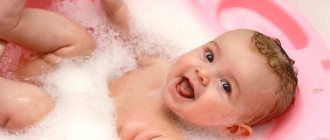February 12, 2017
Averyanova Sveta
Parents are very upset by their child's fear during bathing. Why a child is afraid of water is not always clear. This behavior is an exception to the rule. Usually, children enjoy water procedures greatly.
To cope with the problem of childhood hydrophobia, it is necessary to understand the peculiarities of children’s perception. When the child is calm during bathing, this procedure benefits his health. It is important to understand the causes of children's fear in order to prevent its occurrence. What to do if a child is afraid of water? Every bath can be a little torture. Take advantage of the expert advice at the end of the article.
HELP OF A CHILD PSYCHOLOGIST FOR AQUAPHOBIA?
How nice it is to look at your baby splashing happily in the bath or pool. It's nice to know that a child already knows how to swim or is learning to swim, and will be able to withstand dangerous elements if he has to face them in life. However, not all kids enthusiastically accept various types of water procedures: there are also those who greet every trip to the bathroom with a loud, heartbreaking cry, turning even ordinary washing into an “ascent to Calvary.”
Most babies who started swimming in infant swimming classes before the age of 12-15 months usually treat the water element with great interest and joy: for them, bathing or swimming is always a holiday. However, children who started swimming at the age of over a year and a half often have a negative attitude towards water and even a pronounced fear of it - aquaphobia. In this case, most likely, parents will need the support and help of a child psychologist. Fortunately, there are several ways to solve the problem of a child's fear of water.
What child psychology experts advise
Experts recommend first trying the most effective technique - distraction. It is quite possible to refuse bathing for several days, but hygiene procedures (washing, wiping with wet wipes) must be carried out regularly. During the experiment, you should not take your baby to the bathroom or show him the shower. Usually 4–5 days are enough for contact to resume. Just keep in mind that you need to gradually accustom your little one to water again and, of course, without repeating previous mistakes. It is worth listening to a number of other advice from psychologists.
Practice dry bathing in a tub
Cover the bottom of the bathtub or basin with a diaper, sit your baby there and let him play with his favorite toys. It is desirable that they be suitable for swimming, since over time, when the bath is already filled with water, the baby will definitely want his “friends” to swim with him.
When practicing dry bathing, pour water into the bath a little at a time - this way the baby will not be afraid of large volumes.
Swim together
If there are older children in the family, you can try to bathe them together. Looking at the example of a brother or sister, the baby will overcome his fear. If you only have one toddler, then take a bath with him - there’s nothing scary about it.
It is worth noting that in families with older children, children are less likely to be afraid of water - the imitation effect is triggered.
Bathing together is one of the most effective ways to overcome a child’s fear of water.
Change your intonation
You can get a 2-3 year old child interested in water if you change the intonation in the voice inviting him to swim. When the baby is called not by the mother, but by a kind sorceress, the child will be guaranteed to have more inspiration and desire to go wash. In addition, when you bring your baby to the bathroom, act gradually, form a trusting relationship with the water: first touch the stream from the tap, then stroke it with your palm, etc.
Make bathing exciting by playing
The game will help you overcome your fear of water. Moreover, the more intricate the plot, the better.
Kids like to imagine themselves as animals or fairy-tale characters, and this should be used when teaching them to bathe. Think of something from the series “The Whale and Other Ocean Inhabitants”: the father whale is a very strong inhabitant of the deep sea, he loves the mother killer whale and the baby whales. Tell your baby about the lifestyle of sea inhabitants, explain that baby whales cannot go without water for a long time. At the same time, lure your child into the bathroom. But there, give your child freedom of creativity - let him snort, blow fountains, in general, behave like a real whale.
You can come up with many such stories, thereby turning swimming into fun fun.
Children enjoy playing in the bath with their favorite toys
Visit open waters
Of course, this method of overcoming the fear of swimming will be most suitable for those who live near a river or lake, but you can also try it in a pool. It is very important that the child sees how other children and adults swim - the imitation mechanism will work, the child will want to be “like everyone else.” And when he asks to join the swimmers, consider that half the job is done: you will probably want to repeat this pleasant activity at home. If training takes place at sea, then first walk barefoot on the beach, play with pebbles, feed the fish. The baby will learn to perceive water differently and will stop considering it something hostile.
The most important thing when swimming is not to forget about safety
WHY IS A CHILD AFRAID OF WATER?
Why does a child have a fear of water? Very often, during the development process, young children receive a distorted, unrealistic idea of the potential dangers of the water element.
At the age of 9 months, the baby first understands that he exists separately from his father and mother. This awareness can be the cause of psychological stress, which manifests itself in tears and fears every time the parents leave the room. Placing a child in a separate environment, container or room from the parents can link the fear of separation from the parents to the bath or pool.
At the age of two years, fears of water may be due to illogical conclusions from one’s own observations. For example, watching bath water drain down the drain, a child may think that he too might be sucked into the drain and die. Or watching other children dive and disappear under water, he may imagine that they are drowning.
At three years old, children have a well-developed imagination, but have not yet learned to distinguish between reality and the world of fiction based on works of fiction. Children's fantasies at this age can create fairy-tale monsters and monsters living under water or in sewer pipes that can absorb them.
At any age, negative experiences associated with bathing or swimming, for example, slipping or unexpectedly diving headlong under water, getting injured or being startled by a sharp sound (a motor boat on the beach) or someone's joke, can develop a persistent fear of water.
Getting shampoo, soap, or chlorinated water into the eyes, nose, and mouth can also create a persistent reluctance in a child of any age to repeat this unpleasant experience associated with water.
Safe Swimming Rules
The normal development of the baby, his physical and psychological state depend on the care of adults. To avoid fear of water, and to ensure that water procedures bring only positive emotions and health benefits, you need to follow the rules of safe swimming:
- The temperature of the water in the bath should not exceed the maximum permissible norm. For a baby, water from 36 to 37 degrees is comfortable. It must be measured using a water thermometer. The elbow or the back of the hand is an unreliable method.
- It is necessary to bathe the baby in a comfortable bathtub. If you bought a regular baby bathtub without a built-in slide, purchase it separately. You can install a hanging hammock instead of a slide or put a rubber mat on the bottom.
- For a baby in the first months of life, do not pour a lot of water into the bath without special devices, so that the baby does not end up completely under water during bathing, slipping off your hand.
- Do not wash the bathtub with household chemicals. This can only be done with baby soap or shampoo. Any household chemicals can cause allergies in a baby.
- Shampoo should be used once or twice a week while bathing.
Not only should it be safe for children's eyes and skin, but it should also be applied correctly. Do not allow excessive foam and soap to get into your eyes. Rinse off the shampoo using your hand or a soft sponge so that the water does not pour onto your face, but flows down from the back of your head. - While bathing, speak kindly to your baby, smile at him, let him see the calm and joy on your face. You can recite nursery rhymes and sing songs. Never leave your child unattended in the bath.
- You don’t need to rub the baby too hard with a towel, just wrap it up and gently blot away the moisture.
TECHNIQUES TO ELIMINATE A CHILD'S FEARS OF WATER
Before you can understand how to help your child cope with his fears, you need to find out what he is actually afraid of. Children who can already speak can be asked to talk about their fears. But this doesn't always work out. In such cases, the child can be asked to draw something that he would not like to experience in the water or to show his fear in playing with dolls or toys.
When the cause of fear is clear, you can work with it.
If the main reason is fear of separation from parents, then the best way would be to take a bath or swim in the pool together. Then, as the child gets used to the water, the time spent with him in the water can be gradually reduced, alternating between separate and shared swimming or bathing with the child.
If you have problems with shampoo or soap, you can use neutral baby shampoo and prevent shampoo from getting into your eyes with a visor or swimming goggles.
If the fear is caused by the possibility of being sucked into the sewer, you can demonstrate to the child on a doll that even she will not be able to fit into the small drain hole.
If the fear is caused by underwater monsters from fantasies, talk to your child about the difference between fiction and reality: prove to them that there are no monsters and sharks in the bathtub and there may be monsters. Use goggles or a mask so your child can see underwater.
To get used to water, you can use the desensitization method, that is, a gradual decrease in sensitivity. To do this, the child is gradually accustomed to water, starting with wiping with a damp cloth, immersing his hands in water and continuing with taking a shower, immersing his feet and, gradually, the whole body in water. Achievements at each stage must be reinforced with encouragement, and in every possible way show how proud you are of the child’s achievements - children usually really want to please their parents. Respect your child's feelings and fears and don't push him to go faster than he can.
Reasons for fear of water
Before you figure out what to do with your baby’s fear, find the reason for its appearance. The hygiene procedure often causes serious discomfort, and the occurrence of a phobia is often preceded by an unpleasant situation: the baby slipped, fell or hurt himself.
- Water pressure too strong. Babies are frightened by its noise or the sensation when the jet touches the skin.
- Liquid getting on the face, inside the nose, ears. Water inside the ear can trigger the growth of bacteria and cause pain. The feeling of liquid on the face is unpleasant for babies.
- The shampoo got into the mucous membrane of the eye and caused a sharp pain. This is a common reason: parents switch to products for older children too early.
- During the hygiene procedure, the parents yelled at the baby. He defends himself against adults with hysterics, because he is afraid of causing anger again. Indirect reasons often include: tense relationships between parents, their quarrels and conflicts.
- Uncomfortable water temperature.
Children over one year old have a developed imagination; they imagine something inside the drain hole. Babies may be afraid of water due to the change from a small plastic bath to a regular, spacious one. It is easier to rid your child of fear if he already knows how to talk.
RECOMMENDATIONS IF A CHILD HAS CHILDHOOD FEARS
Express confidence in your child by talking about him in his presence to other people, for example, to the swimming instructor: “Yes, Daniel is a little nervous, he needs a little time to get used to the water,” rather than perpetuating the fear with the phrase “Daniel was scared of the pool.” "
- Praise and encourage your child when he or she tries to overcome fear. Reassure him that he will succeed eventually.
- Find stories in which characters deal with their fear of water and read them to your child: The Boy Who Wouldn't Swim by Deb Lacke or Edward in Deep Water by Rosemary Wells.
- Teach your child to speak out, freeing the soul from daily experiences, grievances and disappointments. Children who are very worried and suffer from daytime worries are more afraid of water than others.
- Avoid watching scary movies, stories or images about water, swimming pools or baths.
- Stay calm yourself. When your child shows signs of fear, be kind, sensitive, and responsive. Tell him that you understand that he is afraid and that everyone gets scared sometimes. But don't let sympathy turn into excessive worry - when a child sees worried parents or senses their nervousness or fear, he becomes even more afraid. This is a reflex that has passed through evolution from animals, which determines better survival in the pack.
- Teach your child how to relax the body before bathing or swimming. Teach him to tense and relax his muscles, to breathe using his stomach (diaphragm). Taking deep, slow breaths reduces fears in 40% of children.
- A great way to overcome fear is “dry swimming” - gymnastics on land that imitates movements in water. It is more effective if an instructor does such gymnastics with the child.
Let's try to find a way out of the situation so that both the baby and you are happy and calm.
• Most beaches have “paddling pools in which children enthusiastically splash around without any fear. Show this to your baby, maybe he will accept your offer.
• A grown-up child can be captivated by stories about the underwater world and its inhabitants. True, for this, parents need to stock up on the necessary equipment and learn more about the subject of interest themselves.
• Don't forget about such wonderful tools as an air mattress, circle or armbands. Many children learned to swim fearlessly thanks to these things.
But if your child firmly insists that he will never go into the water, accept it. The main thing is that he is satisfied and happy.
SHAKEDOWN CRUISE
In order to be sure that your child will cope with himself and will be able to take up swimming, you can attend a trial swimming lesson with us.
An experienced instructor will be at the lesson, and you will be able to understand whether the baby is ready to perceive water as his native element. You can sign up for swimming either through the form on the website, or by phone, or via chat.
If your child’s fears of water persist, seek help from a child psychologist. It is important to know that phobias can be a symptom of other disorders for which the child will need professional help, for example, phobias can signal attention deficit hypermobility disorder.











